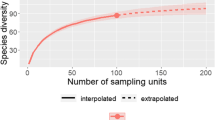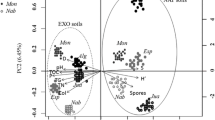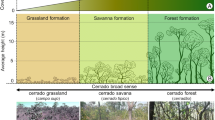Abstract
Impoundment of the Three Gorges Reservoir (TGR) has dramatically influenced the riparian environment and shaped a new drawdown zone, which has experienced long-term winter conditions and short periods of summer flooding. The community structure and diversity of arbuscular mycorrhizal (AM) fungi (AMF) were investigated in three areas with different fertilization histories [Area A (5 years of fertilization), Area B (3 years of fertilization) and Area C (no fertilization)] in the drawdown zone of the TGR. Altogether, 50 AMF species were identified; the genera Acaulospora, Funneliformis and Glomus were predominant. The AM fungal community differed among areas A, B and C. A higher isolation frequency and relative abundance of Acaulospora, Ambispora, Entrophospora and Paraglomus were observed in areas A and B; however, Claroideoglomus, Diversispora, Sclerocystis and Septoglomus were more abundant in Area C. The highest spore density occurred in Area C, and was slightly lower in Area A and lowest in Area B. Conversely, species richness and diversity indices (Shannon–Wiener and evenness indices) were the highest in Area A, followed by areas C and B. Based on nonmetric multidimensional scaling analyses, the distribution of AMF was influenced by plant host, fertilization practice and environmental factors. Among them, the soil physicochemical properties were the main drivers affecting AMF, in which three edaphic attributes (carbon/nitrogen ratio, available phosphorus and potassium content) were significantly correlated (P < 0.001) with the AM fungal community composition in the three areas of the drawdown zone of the TGR.

Similar content being viewed by others
References
Alguacil MM, Torrecillas E, García-Orenes F, Roldán A (2014) Changes in the composition and diversity of AMF communities mediated by management practices in a Mediterranean soil are related with increases in soil biological activity. Soil Biol Biochem 76:34–44
Augé RM (2001) Water relations, drought and vesicular–arbuscular mycorrhizal symbiosis. Mycorrhiza 11:3–42
Barto EK, Rillig MC (2010) Does herbivory really suppress mycorrhiza? A meta-analysis. J Ecol 98:745–753
Boddington CL, Dodd JC (2000) The effect of agricultural practices on the development of indigenous arbuscular mycorrhizal fungi. I. Field studies in an Indonesian ultisol. Plant Soil 218:137–144
Brundrett M, Melville L, Peterson L (1994) Practical methods in mycorrhizal research. Mycologue, Waterloo
Caravaca F, Barea JM, Palenzuela J, Figueroa D, Alguacil MM, Roldán A (2003) Establishment of shrub species in a degraded semiarid site after inoculation with native or allochthonous arbuscular mycorrhizal fungi. Appl Soil Ecol 22:103–111
Carvalho F, de Souza FA, Carrenho R, Moreira FMS, Jesus EC, Fernandes GW (2012) The mosaic of habitats in the high-altitude Brazilian rupestrian fields is a hotspot for arbuscular mycorrhizal fungi. Appl Soil Ecol 52:9–19
Dai M, Hamel C, St Arnaud M, He Y, Grant C, Lupwayi N, Janzen H, Malhi SS, Yang X, Zhou Z (2012) Arbuscular mycorrhizal fungi assemblages in Chernozem great groups revealed by massively parallel pyrosequencing. Can J Microbiol 58:81–92
Daniell TJ, Hodge A, Young JPW, Fitter A (1999) How many fungi does it take to change a plant community? Trends Plant Sci 4:81–82
Egerton-Warburton LM, Querejeta JI, Allen MF (2007) Common mycorrhizal networks provide a potential pathway for the transfer of hydraulically lifted water between plants. J Exp Bot 58:1473–1483
Guo X, Gong J (2014) Differential effects of abiotic factors and host plant traits on diversity and community composition of root-colonizing arbuscular mycorrhizal fungi in a salt-stressed ecosystem. Mycorrhiza 24:79–94
Hijri I, Sýkorová Z, Oehl F, Ineichen K, Mäder P, Wiemken A, Redecker D (2006) Communities of arbuscular mycorrhizal fungi in arable soils are not necessarily low in diversity. Mol Ecol 15:2277–2289
Jacobson KM (1997) Moisture and substrate stability determine VA mycorrhizal fungal community distribution and structure in an arid grassland. J Arid Environ 35:59–75
Jansa J, Mozafar A, Anken T, Ruh R, Sanders IR, Frossard E (2002) Diversity and structure of AMF communities as affected by tillage in a temperate soil. Mycorrhiza 12:225–234
Ji B, Bentivenga SP, Casper BB (2012) Comparisons of AM fungal spore communities with the same hosts but different soil chemistries over local and geographic scales. Oecologia 168:187–197
Jiao H, Chen Y, Lin X, Liu R (2011) Diversity of arbuscular mycorrhizal fungi in greenhouse soils continuously planted to watermelon in North China. Mycorrhiza 21:681–688
Johnson NC, Angelard C, Sanders IR, Kiers TE (2013) Predicting community and ecosystem outcomes of mycorrhizal responses to global change. Ecol Lett 16:140–153
Kennedy TA, Naeem S, Howe KM, Knops JM, Tilman D, Reich P (2002) Biodiversity as a barrier to ecological invasion. Nature 417:636–638
Koske RE, Tessier B (1983) A convenient, permanent slide mounting medium. Mycol Soc Am Newsl 34:59
Landis FC, Gargas A, Givnish TJ (2004) Relationships among arbuscular mycorrhizal fungi, vascular plants and environmental conditions in oak savannas. New Phytol 164:493–504
Lei S, Zeng B, Yuan Z, Su X (2014) Changes in carbohydrate content and membrane stability of two ecotypes of Calamagrostis arundinacea growing at different elevations in the drawdown zone of the Three Gorges Reservoir. PLoS ONE 9:e91394
Lekberg Y, Koide RT, Rohr JR, Aldrich-Wolfe L, Morton JB (2007) Role of niche restrictions and dispersal in the composition of arbuscular mycorrhizal fungal communities. J Ecol 95:95–105
Li T, Li JP, Zhao ZW (2004) Arbuscular mycorrhizas in a valley-type savanna in southwest China. Mycorrhiza 14:323–327
Li LF, Li T, Zhao ZW (2007) Differences of arbuscular mycorrhizal fungal diversity and community between a cultivated land, an old field, and a never-cultivated field in a hot and arid ecosystem of southwest China. Mycorrhiza 17:655–665
Li LF, Li T, Zhang Y, Zhao ZW (2010) Molecular diversity of arbuscular mycorrhizal fungi and their distribution patterns related to host-plants and habitats in a hot and arid ecosystem, southwest China. FEMS Microbiol Ecol 71:418–427
Likar M, Hančević K, Radić T, Regvar M (2013) Distribution and diversity of arbuscular mycorrhizal fungi in grapevines from production vineyards along the eastern Adriatic coast. Mycorrhiza 23:209–219
Luo FL, Wang L, Zeng B, Ye XQ, Chen T, Liu D, Zhang YH, Kuhn Arnd (2006) Photosynthetic responses of the riparian plant Arundinella anomala Steud. In Three Gorges Reservoir Region as affected by simulated flooding. Acta Ecol Sin 26:3602–3609 (in Chinese)
Maia SMF, Xavier FAS, Oliveira TS, Mendonça ES, Araújo Filho JA (2006) The impact of agroforestry and conventional systems on the soil quality from Cearense semi-arid region. Rev Árvore 30:837–848
Marulanda A, Barea JM, Azcón R (2006) An indigenous drought-tolerant strain of Glomus intraradices associated with a native bacterium improves water transport and root development in Retama sphaerocarpa. Microb Ecol 52:670–678
McGonigle TP, Miller MH, Evans DG, Fairchild GL, Swan JA (1990) A new method which gives an objective measure of colonization of roots by vesicular arbuscular mycorrhizal fungi. New Phytol 115:495–501
Miller SP (2000) Arbuscular mycorrhizal colonization of semi-aquatic grasses along a wide hydrologic gradient. New Phytol 145:145–155
Morton JB (1988) Taxonomy of mycorrhizal fungi: classification, nomenclature, and identification. Mycotaxon 32:267–324
Morton JB (1993) Problems and solutions for integration of glomalean taxonomy, systematic biology, and the study of endomycorrhizal phenomena. Mycorrhiza 2:97–109
Morton JB, Redecker D (2001) Two new families of Glomales, Archaesporaceae and Paraglomaceae, with two new genera Archaespora and Paraglomus, based on concordant molecular and morphological characters. Mycologia 93:181–195
Munkvold L, Kjøller R, Vestberg M, Rosendahl S, Jakobsen I (2004) High functional diversity within species of arbuscular mycorrhizal fungi. New Phytol 164:357–364
New T, Xie Z (2008) Impacts of large dams on riparian vegetation: applying global experience to the case of China’s Three Gorges Dam. Biodivers Conserv 17:3149–3163
Nielsen KB, Kjøller R, Olsson PA, Schweiger PF, Andersen FO, Rosendahl S (2004) Colonisation and molecular diversity of arbuscular mycorrhizal fungi in the aquatic plants Littorella uniflora and Lobelia dortmana in southern Sweden. Mycol Res 108:616–625
Oehl F, Sieverding E, Mäder P, Dubois D, Ineichen K, Boller T, Wiemken A (2004) Impact of long-term conventional and organic farming on the diversity of arbuscular mycorrhizal fungi. Oecologia 138:574–583
Oehl F, Sieverding E, Ineichen K, Ris EA, Boller T, Wiemken A (2005) Community structure of arbuscular mycorrhizal fungi at different soil depths in extensively and intensively managed agroecosystems. New Phytol 165:273–283
Oehl F, Laczko E, Bogenrieder A, Stahr K, Bösch R, van der Heijden M, Sieverding E (2010) Soil type and land use intensity determine the composition of arbuscular mycorrhizal fungal communities. Soil Biol Biochem 42:724–738
Oehl F, Da Silva GA, Goto BT, Sieverding E (2011) Glomeromycota: three new genera and glomoid species reorganized. Mycotaxon 116:75–120
Oksanen J (2011) Multivariate Analysis of Ecological Communities in R: Vegan Tutorial. http://cc.oulu.fi/∼jarioksa/opetus/metodi/vegantutor.pdf
Oksanen J, Blanchet F, Kindt R, Legendre P, Minchin P, O’Hara B, Simpson G, Solymos P, Stevens M, Wagner H (2012) vegan: Community Ecology Package R Package Version 2.0-4. P 190 http://cran.r-project.org/http://vegan.r-forge.r-project.org/
Pagano MC, Zandavalli RB, Araújo FS (2013) Biodiversity of arbuscular mycorrhizas in three vegetational types from the semiarid of Ceará State, Brazil. Appl Soil Ecol 67:37–46
Phillips JM, Hayman DS (1970) Improved procedures for clearing roots and staining parasitic and vesicular-arbuscular mycorrhizal fungi for rapid assessment of infection. Trans Br Mycol Soc 66:1255–1259
Porras-Alfaro A, Herrera J, Natvig DO, Sinsabaugh RL (2007) Effect of long-term nitrogen fertilization on mycorrhizal fungi associated with a dominant grass in a semiarid grassland. Plant Soil 296:65–75
Redecker D, Schüßler A, Stockinger H, Stürmer SL, Olsen SR, Sommers LE (1982) Phosphorus. In: Page AL, Miller RH, Keeney DR (eds) Methods of soil analysis, part 2. Am Soc Agron, Soil Sci Soc AM, Madison, Wisconsin, pp 403–430
Redecker D, Schüßler A, Stockinger H, Stürmer SL, Morton JB, Walker C (2013) An evidence-based consensus for the classification of arbuscular mycorrhizal fungi (Glomeromycota). Mycorrhiza 23:515–531
Reinhart KO, Callaway RM (2006) Soil biota and invasive plants. New Phytol 170:445–457
Saravesi K, Ruotsalainen AL, Cahill JF (2014) Contrasting impacts of defoliation on root colonization by arbuscular mycorrhizal and dark septate endophytic fungi of Medicago sativa. Mycorrhiza 24:239–245
Schmid T, Meyer J, Oehl F (2008) Integration of mycorrhizal inoculum in high alpine revegetation. In: Feldmann F, Kapulnik Y, Baar J (Eds.) Mycorrhiza Works. Proceedings of the International Symposium‘Mycorrhiza for Plant Vitality’ and the Joint Meeting of Working Groups 1-4 of COST Action 870. Deutsche Phytomedizinische Gesellschaft, Braunschweig, Germany, pp 278–288
Schüßler A, Walker C (2010) The Glomeromycota. A species list with new families and new genera. Arthur Schüßler and Christopher Walker, Gloucester. Published in December 2010 in libraries at The Royal Botanic Garden Edinburgh, The Royal Botanic Garden Kew, Botanische Staatssammlung Munich, and Oregon State University. Printed copy available under ISBN-13: 978-1466388048, ISBN-10: 1466388048. Available at http://www.amf-phylogeny.com
Shafroth PB, Stromberg JC, Patten DT (2002) Riparian vegetation response to altered disturbance and stress regimes. Ecol Appl 12:107–123
Shi Z, Zhang L, Li X, Feng G, Tian C, Christie P (2007) Diversity of arbuscular mycorrhizal fungi associated with desert ephemerals in plant communities of Junggar Basin, northwest China. Appl Soil Ecol 35:10–20
Smith SE, Read DJ (2008) Mycorrhizal symbiosis, 3rd edn. Academic Press, San Diego, pp 11–145
Smith SE, Smith FA (2011) Roles of arbuscular mycorrhizas in plant nutrition and growth: new paradigms from cellular to ecosystem scales. Annu Rev Plant Biol 62:227–250
Soteras F, Grilli G, Cofré MN, Marro N, Becerra A (2014) Arbuscular mycorrhizal fungal composition in high montane forests with different disturbance histories in central Argentina. Appl Soil Ecol 85:30–37
Šraj-Kržič N, Pongrac P, Klemenc M, Kladnik A, Regvar M, Gaberščik A (2006) Mycorrhizal colonisation in plants from intermittent aquatic habitats. Aquat Bot 85:331–336
Stürmer SL (2012) A history of the taxonomy and systematics of arbuscular mycorrhizal fungi belonging to the phylum Glomeromycota. Mycorrhiza 22:247–258
Tenten N, Zeng B, Kazda M (2010) Soil stabilizing capability of three plant species growing on the Three Gorges Reservoir riverside. J Earth Sci 21:888–896
Thonar C, Schnepf A, Frossard E, Roose T, Jansa J (2011) Traits related to differences in function among three arbuscular mycorrhizal fungi. Plant Soil 339:231–245
van der Heijden MGA, Klironomos JN, Ursic M, Moutoglis P, Streitwolf-Engel R, Boller T, Wiemken A, Sanders IR (1998) Mycorrhizal fungal diversity determines plant biodiversity, ecosystem variability and productivity. Nature 396:69–72
van der Heijden MGA, Streitwolf-Engel R, Riedl R, Siegrist S, Neudecker A, Ineichen K, Boller T, Wiemken A, Sanders IR (2006) The mycorrhizal contribution to plant productivity, plant nutrition and soil structure in experimental grassland. New Phytol 172:739–752
Vivas A, Vörös I, Biró B, Campos E, Barea JM, Azcón R (2003) Symbiotic efficiency of autochthonous arbuscular mycorrhizal fungus (G. mosseae) and Brevibacillu ssp. isolated from cadmium polluted soil under increasing cadmium levels. Environ Pollut 126:179–189
Walker C, Mize W, McNabb HS (1982) Populations of endogonaceous fungi at two populations in central lowa. Can J Bot 60:2518–2529
Wang B, Qiu YL (2006) Phylogenetic distribution and evolution of mycorrhizas in land plants. Mycorrhiza 16:299–363
Wang YY, Vestberg M, Walker C, Hurme T, Zhang X, Lindström K (2008) Diversity and infectivity of arbuscular mycorrhizal fungi in agricultural soils of the Sichuan Province of mainland China. Mycorrhiza 18:59–68
Wang Y, Qiu Q, Yang Z, Hu Z, Tam N, Xin G (2010) Arbuscular mycorrhizal fungi in two mangroves in South China. Plant Soil 331:181–191
Wang Y, Huang Y, Qiu Q, Xin G, Yang Z, Shi S (2011) Flooding greatly affects the diversity of arbuscular mycorrhizal fungi communities in the roots of wetland plants. PLoS ONE 6:e24512
Wang Q, Yuan X, Willison JH, Zhang Y, Liu H (2014) Diversity and above-ground biomass patterns of vascular flora induced by flooding in the drawdown area of China’s three gorges reservoir. PLoS ONE 9:e100889
Wantzen KM, Rothhaupt KO, Mörtl M, Cantonati M, László G, Fischer P (2008) Ecological effects of water-level fluctuations in lakes. Hydrobiologia 613:1–4
Wetzel PR, van der Valk AG (1996) Vesicular–arbuscular mycorrhizae in prairie pothole wetland vegetation in Iowa and North Dakota. Can J Bot 74:883–890
Wetzel K, Silva G, Matczinski U, Oehl F, Fester T (2014) Superior differentiation of arbuscular mycorrhizal fungal communities from till and no-till plots by morphological spore identification when compared to T-RFLP. Soil Biol Biochem 72:88–96
Wilde P, Manal A, Stodden M, Sieverding E, Hildebrandt U (2009) Biodiversity of arbuscular mycorrhizal fungi in roots and soils of two salt marshes. Environ Microbiol 11:1548–1561
Willison JM, Li R, Yuan X (2013) Conservation and ecofriendly utilization of wetlands associated with the Three Gorges Reservoir. Environ Sci Pollut Res 20:6907–6916
Wirsel SGR (2004) Homogeneous stands of a wetland grass harbour diverse consortia of arbuscular mycorrhizal fungi. FEMS Microbiol Ecol 48:129–138
Wu QS, Srivastava AK, Zou YN (2013) AMF-induced tolerance to drought stress in citrus. Sci Hortic 164:77–87
Yang L, Deng HP, Han M, Lei SY (2008) Seed characteristics of Distylium chinense (Fr.) Diels the Three Gorges Reservoir Region. J Southwest Univ 30:79–84 (in Chinese)
Ye C, Cheng X, Zhang Y, Wang Z, Zhang Q (2012) Soil nitrogen dynamics following short-term revegetation in the water level fluctuation zone of the Three Gorges Reservoir, China. Ecol Eng 38:37–44
Ye C, Zhang K, Deng Q, Zhang Q (2013) Plant communities in relation to flooding and soil characteristics in the water level fluctuation zone of the Three Gorges Reservoir, China. Environ Sci Pollut Res 20:1794–1802
Zangaro W, Moreira M (2010) Micorrizas arbusculares nos biomas Floresta Atlântica e Floresta de Araucária. In: Siqueira JO, de Souza FA, Cardoso EJBN, Tsai SM (eds) Micorrizas 30 anos de pesquisa no Brasil. UFLA, Lavras, pp 279–310
Zhang Y, Guo LD, Liu RJ (2004) Survey of arbuscular mycorrhizal fungi in deforested and natural forest land in the subtropical region of Dujiangyan, southwest China. Plant Soil 261:257–263
Zhao DD, Zhao ZW (2007) Biodiversity of arbuscular mycorrhizal fungi in the hot-dry valley of the Jinsha River, southwest China. Appl Soil Ecol 37:118–128
Zhao CM, Chen WL, Huang HD, Tian ZQ, Chen Y, Xie ZQ (2007) Spatial pattern of plant species diversity in the inundation and resettlement region of the Three Gorges Reservoir. Biodivers Sci 15:510–522 (in Chinese)
Acknowledgments
The authors thank anonymous referees for constructive comments and suggestions that improved the manuscript. We are very grateful to anonymous AMF taxonomists for their help with the morphological identification of spores of AMF. The Natural Science Foundation of Chongqing (Grant No. cstc2012jjA20012), the National Natural Science Foundation of China (Grant No. 31270091) and the Scientific Research Foundation of Southwest University to Dr. Jinyan Dong (Grant No. swu109046) supported this work financially.
Author information
Authors and Affiliations
Corresponding author
Ethics declarations
Conflict of interest
The authors have no conflicts of interest to declare.
Electronic supplementary material
Below is the link to the electronic supplementary material.
About this article
Cite this article
Luo, X., Su, X., Cui, J. et al. Biodiversity of arbuscular mycorrhizal fungi in the drawdown zone of the Three Gorges Reservoir under different fertilization histories. Ecol Res 31, 407–416 (2016). https://doi.org/10.1007/s11284-016-1356-9
Received:
Accepted:
Published:
Issue Date:
DOI: https://doi.org/10.1007/s11284-016-1356-9




